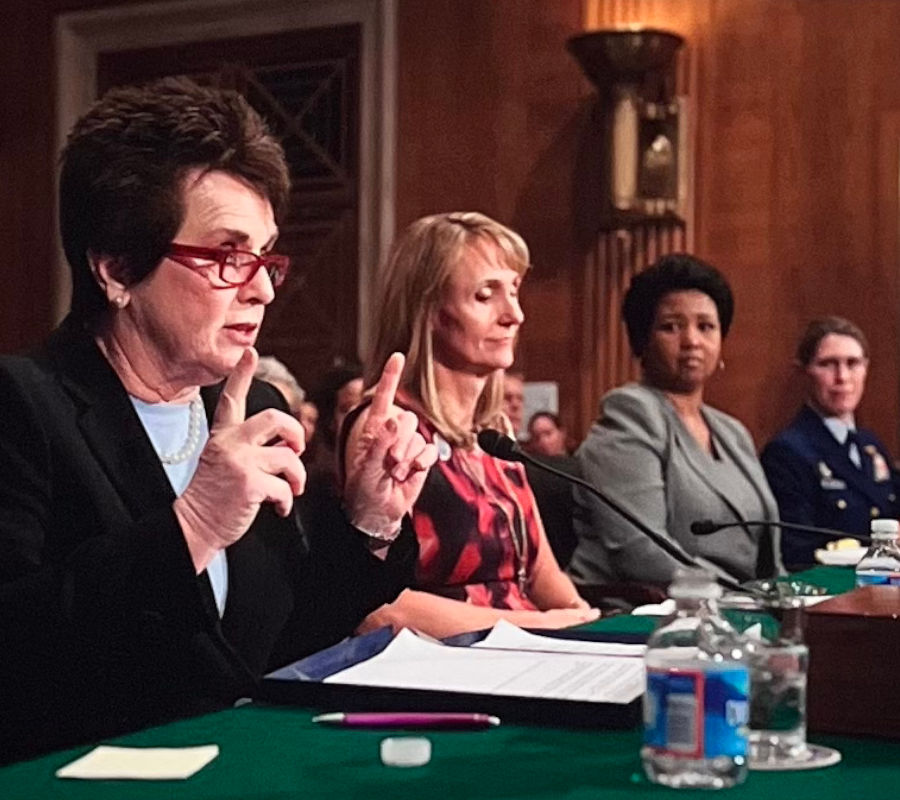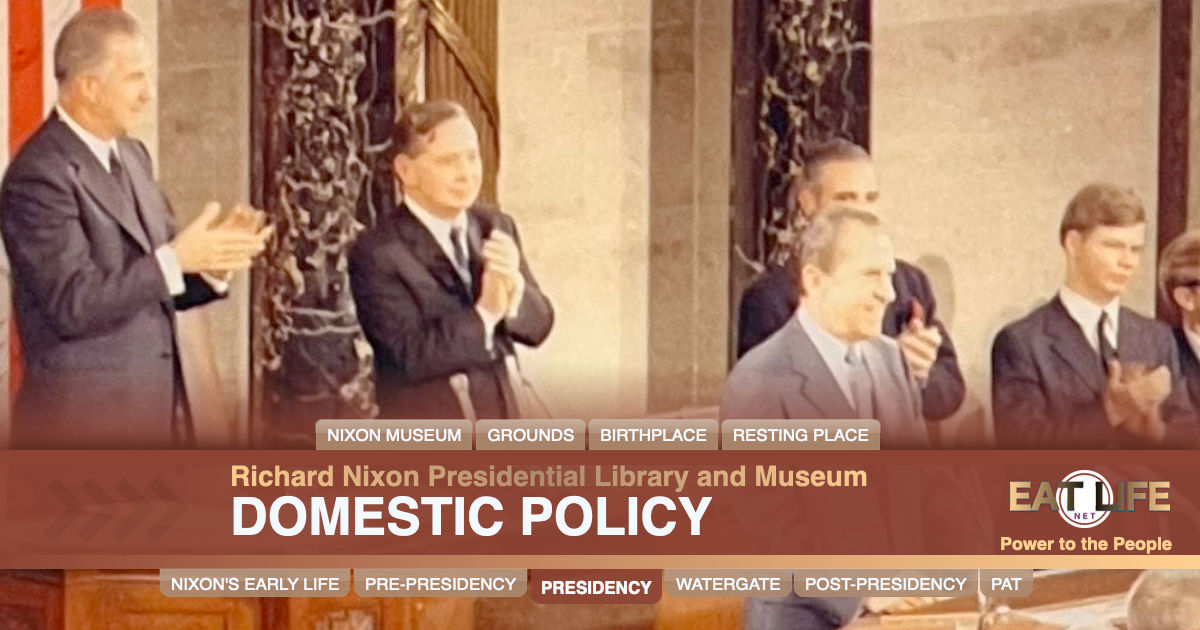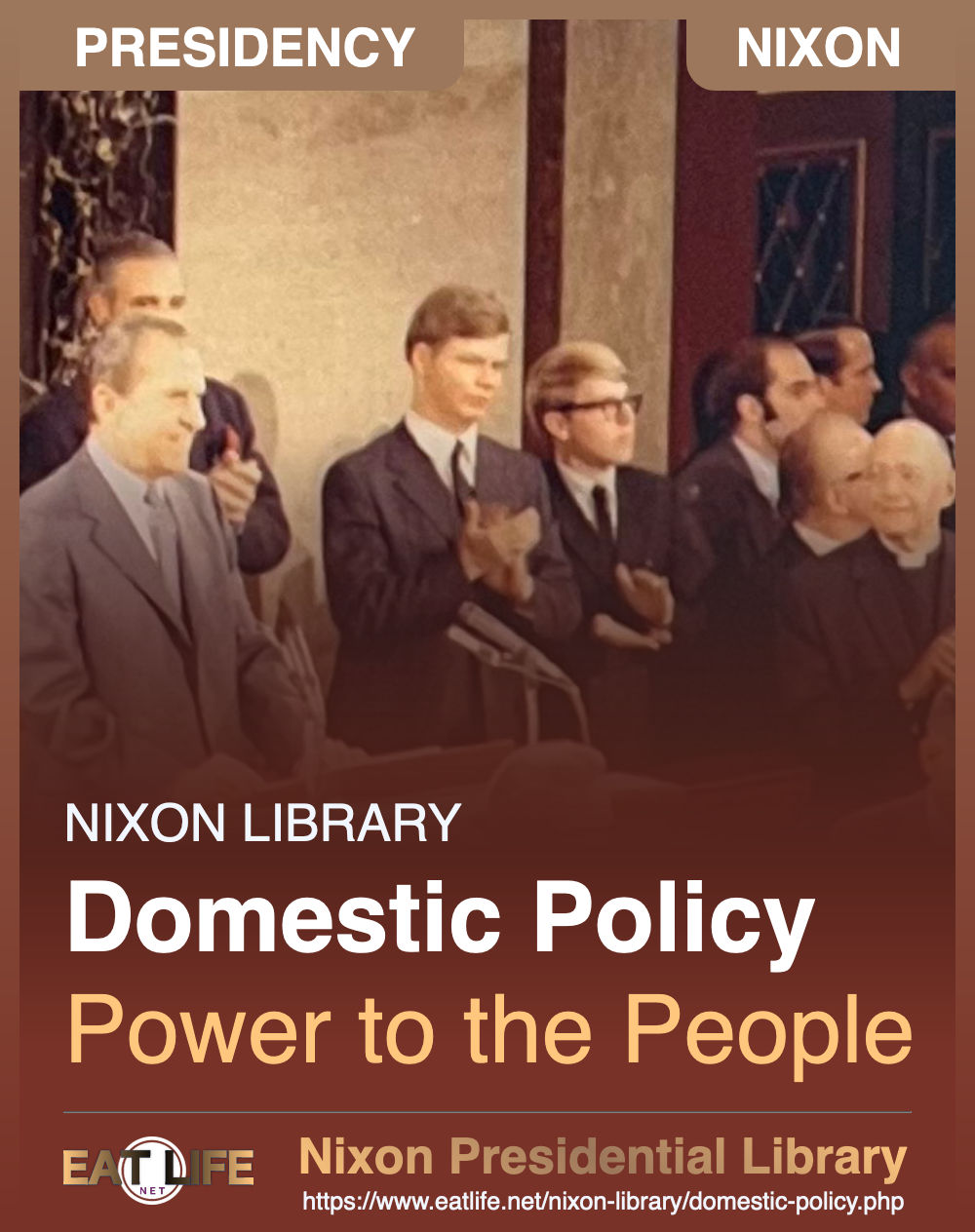The time has now come in America to reverse the flow of power and resources ... from Washington to the States and communities and, more importantly, to the people all across America.
- 1971 State of the Union Address
He sought to spark what he called a New American Revolution. Nixon believed that President Johnson's anti-poverty programs were ineffective and too costly. Instead he proposed to return power to state and local governments and focus on holding the line on Federal spending. Nixon addressed a variety of domestic issues with a mixture of principled pragmatism and political calculation.
Nixon was the first incoming President in 120 years to face a Congress completely controlled by the opposing party, and only some of his domestic proposals became law.
Above all, what this congress can be remembered for is opening the way to a new American Revolution - A peaceful revolution in which power was turned back to the people - in which government at all levels was refreshed and renewed and made truly responsive.
- 1971 State of the Union Address
For example: To address the problems of crime and poverty in America's cities, he moved policy initiation into the White House through the creation of the Urban Affairs Council. The Council (later folded by Nixon into the Domestic Council under John Ehrlichman) coordinated the dozens of urban programs spread across the Government to make them more efficient and more effective.
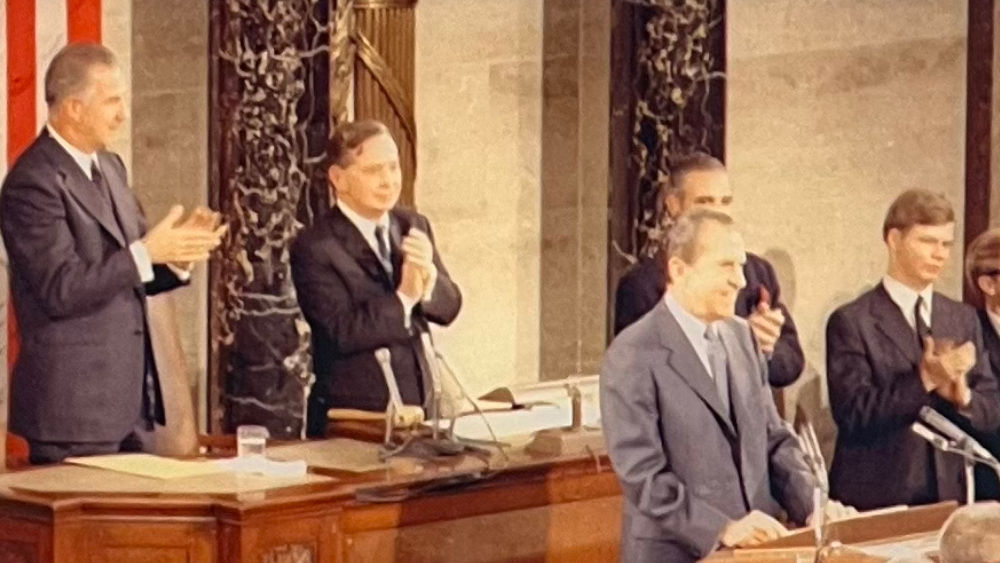
- January 22, 1971 - President Nixon's State of the Union address calls for a "New American Revolution"
The time has come for a new partnership between the Federal Government and the states and localities ... let us put the money where the needs are. And let us put the power to spend it where the people are.
- January 22, 1971
He believed that local and state governments, because they were closer to the people, were in a far better position to address the nation's domestic challenges.
As President, Nixon returned billions of Federal tax dollars to governors and mayors all across America through a program of "revenue sharing" - an approach that was part of what he called New Federalism.
In addition, Nixon's New Federalism took aim at the nation's welfare program, which he believed was robbing people of the dignity of work and promoting a sense of dependency among its recipients.
Rather than just ending welfare, Nixon proposed a far-reaching replacement of the existing welfare program. Nixon's proposal created incentives for people to work, while also providing assistance for struggling families. Although Nixon's plan didn't pass the Democratic-controlled Congress, a Republican-controlled Congress passed a similar set of reforms in 1996 under President Clinton.
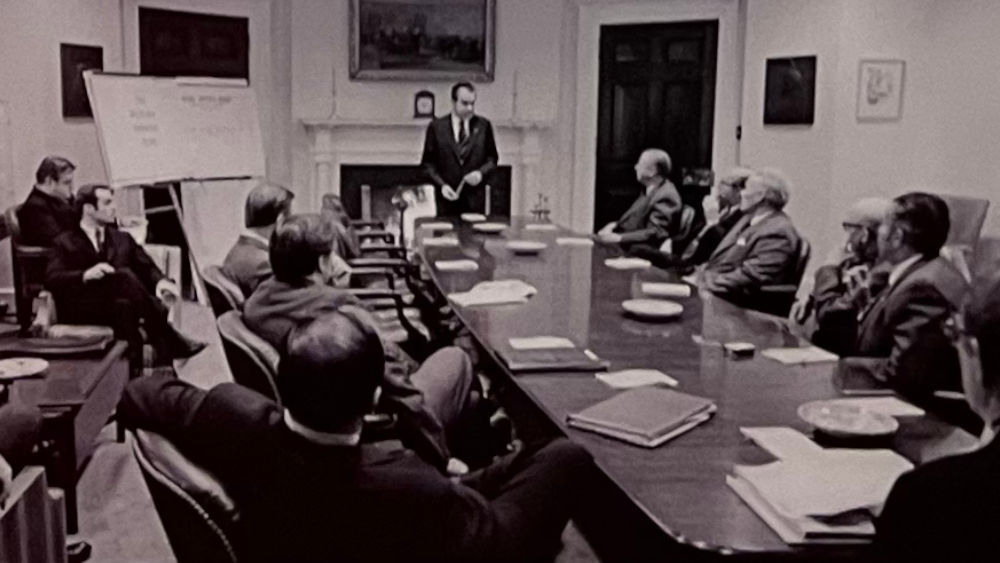
- January 1971 - Following his State of the Union address, President Nixon meets with Congressmen to discuss his plan for Federal revenue sharing.
I shall ask to change the framework of government itself - to reform the entire structure of American Government so we can make it again fully responsive to the needs and the wishes of the American people.
- 1971 State of the Union Address
This principle of New Federalism was applied not just to economic policy but also to social issues such as Native American affairs, desegregation, and more.
For the first time, applying the principles of the New Federalism, administration of a major established Federal program would be turned over to the States and local governments, recognizing that they are in a position to do the job better.
- August 1969
Clean air, clean water, open spaces - these should once again be the birthright of every American.
- 1970 State of the Union Address
The massive job of cleaning up the Great Lakes could not be accomplished by either the United States or by Canada alone. In what would become one of the first international environmental agreements in history, the two nations committed to restore and maintain the quality of the waters of the Great Lakes.
This agreement set the stage for international environmental cooperation for decades to come.
The importance of what we have done this morning cannot be described or measured by conventional means.
- Elliot Trudeau, on signing the Great Lakes Water Quality Agreement with President Nixon in 1972
Acts signed by Nixon, such as the Endangered Species Act of 1973, are still the main legislative tools for protecting wildlife and limiting pollution.
The burning river became a tipping point for public disgust, and people demanded action.
A pragmatist in his approach to domestic affairs, Nixon knew politically that this was a problem he had to address. In his 1970 State of the Union address, President Nixon proposed an ambitious set of environmental goals, including a $10 billion clean water program, pollution controls on automobiles, and an end to dumping in the Great Lakes.
Enacted in 1970, the National Environmental Policy Act established the Environmental Protection Agency to bring together in one agency the responsibility for preserving and protecting America's environment.
Other reforms followed, including
- A comprehensive revision of the Clean Air Act
- The Marine Mammal Protection Act [eatlife.net/nixon-library/reflecting-pool.php]
- The Endangered Species Act [eatlife.net/nixon-library/endangered-species.php]
The same kind of concentrated effort that split the atom and took man to the Moon should be turned toward conquering this dread desease.
- 1970 State of the Union Address
The next year, acknowledging growing vocal public support, he decided to make cancer research a priority.
The National Cancer Act, which President Nixon signed on December 23, 1971, created a new research infrastructure and committed billions of dollars to the cause of finding a cure for cancer.
At the White House signing ceremony, the president of the American Cancer Society enthusiastically called the act "the greatest thing ever done by the United States."
Without adequate health care, no one can make full use of his or her talents and opportunities.
In his first term Nixon proposed a major health insurance overhaul to Congress. The Democratic-controlled Congress defeated the bill. After his reelection, Nixon tried again.
He proposed a plan for sweeping health insurance reform, not replacing Medicare, which had only been created in 1965, but drawing on the power of the private sector to make it more effective. Employers would be required to provide insurance to their workers. Subsidies would assist those who couldn't afford the premiums. And no one would be denied insurance because of existing conditions.
Nixon's resignation and opposition from Capitol Hill put an end to the plan.

Moving Toward Equality
President Nixon inherited a nation struggling to achieve equal rights for all.
- Thousands of African-American children were receiving inferior educations in segregated schools.
- Minority men were sent to fight in Vietnam in disproportionate numbers because of the many draft exemptions of which whites were able to take advantage.
- Women had few legal protections against discrimination.
- Native Americans were protesting to draw attention to decades of cruel and deceptive practices by the Federal Government.
- Hispanic citizens were often left out of the democratic process due to language barriers.
The Civil Rights Act of 1964 and the Voting Rights Act of 1965 had established the legislative basis for equality. President Nixon was confronted with the difficult task of making all Americans accept and obey these laws in their daily lives.
As President, Nixon leveraged his office to raise awareness by publicly meeting with Native American leaders and openly campaigning in Hispanic neighborhoods. He directed Cabinet departments to implement programs and pursue policies that would advance equality and protect women and minorities.
And many of President Nixon's policies and executive actions had long-lasting effects, such as one of the first Federal affirmative action programs and the rapid desegregation of the South's schools.
By promoting a degree of inclusion and diversity, at least in the area of civil rights, the Nixon administration helped set in motion a transformation not just in Washington, DC, but across America.
Throughout 21 years I have not altered my belief that equal rights for women warrant a Constitutional guarantee - and I therefore continue to favor the enactment of the Constitutional Amendment to achieve this goal.
- June 1971
When Vera Glaser, a reporter at his second Presidential press conference, pointed out that only three administration appointments out of 200 were women, Nixon pledged to address the problem. Soon after, he named a Presidential Task Force on Women's Rights and Responsibilities.
The Administration tripled the number of women in policy-making jobs within a year and shattered glass ceilings in a number of fields from forest rangers to generals. Nixon was only the third President to appoint a woman to a Cabinet-level post when he appointed Anne Armstrong as Counselor to the President in 1972. Altogether, the Nixon administration hired more than four times as many women for jobs in the Executive Branch as any previous Presidency.
Title IX began a dramatic increase in funding for girls' sports. In 1972, one in 27 girls played a sport in high school; as of 2015, more than 40 percent of all high school girls participate in athletics.
In seven Southern states, there had been fierce resistance to Federal efforts to enforce the 1954 U.S. Supreme Court's unanimous decision that "separate educational facilities are inherently unequal" in violation of the equal protection clause of the 14th Amendment to the Constitution.
In 1955, the Court ruled that school desegregation needed to occur "with all deliberate speed." But the pace of change remained slow. So in 1969 the Court ruled that desegregation had to occur "at once."
Nixon's New Federalism emphasized steering money and resources to local and state governments to empower them, which allowed him to push for locally sourced and enforced desegregation in America's schools.
In March 1970, Nixon tapped senior members of his administration to create and meet with committees of community leaders from each state, to develop individualized plans to bring about rapid desegregation of the South's schools.
The President met personally with the first six committees in the White House. When the Louisiana committee couldn't reach agreement, Nixon traveled to New Orleans for the final meeting to persuade Louisiana's leaders to take on responsibility for desegregating their schools.
By 1974, the number of African-American students in segregated schools in the South was down from 68 percent to 8 percent.


- February 8, 1970 - A protest against court-ordered busing to achieve integration in public schools in Charlotte, NC

- Two students eat lunch together at a desegregated school in California
The plan forced many cities to develop their own affirmative action plans that covered both Federal and private projects, a legacy that continues to this day.
President Nixon felt that the Federal Government had taken advantage of the First Americans and treated them unfairly. He decided to reverse almost 100 years of Washington policy.
President Nixon returned tribal lands to their tribes, beginning with the sacred Blue Lake in New Mexico. He proposed the Indian Finance Act, providing support for economic development on Native American lands. And he crafted the landmark 1975 legislation that bolstered self-determination by allowing tribes to administer their Federally funded programs.
The time has come to break decisively with the past and to create the conditions for a new era in which the Indian future is determined by Indian acts and Indian decisions.
- July 1970
Beyond implementing purely economic initiatives, Nixon insisted that programs such as environmental reform, space exploration, and other social polices conform to cost-budget standards. He created the Office of Management and Budget - which still exists today - for this purpose.
Nixon's commitment to fiscal responsibility was put to the test when the Clean Water Act was passed in 1972. While an advocate for environmental protections and initially in favor of the legislation, Nixon vetoed the final bill because of the greatly increased $18 billion price tag, but Congress overrode the President's veto.
Now millions of Americans are forced to go into debt today because the Federal Government decided to go into debt yesterday. We must balance our Federal budget so that American families will have a better chance to balance their family budgets.
- 1970 State of the Union Address
In addition there was a wave of serious drug use among U.S. troops in Vietnam. Landmark efforts, supported by the Nixon administration, showed how addressing heroin abuse could reduce urban crime.
In response Nixon announced the War on Drugs, a comprehensive, Federally supported approach to combating the tide of illegal drugs. Nixon's approach to the drug problem didn't begin and end with addressing the manufacturers and dealers. It also required supporting and rehabilitating addicts.
Nixon created a Special Action Office for Drug Abuse Prevention, and the Drug Enforcement Agency (DEA) was founded and new programs launched, many of them focused for the first time on treatment - the human side of the drug problem.
The threat of narcotics among our people is one which properly frightens many Americans ... it is a problem which demands compassion, and not simply condemnation, for those who become the victims of narcotics and dangerous drugs.
- June 1971
The highly unpopular draft compelled military service during Vietnam. Controversy about the draft also fueled a national debate about the voting age of 21. If people were old enough to fight for their country, it was argued, they should also be able to vote.
As President, Nixon appointed in 1969 a high-level commission to study the creation of an all-volunteer armed force as a way of replacing the military draft. He signed legislation to extend the draft two more years, but with a lottery system. He accepted the Commission's recommendation for an all-volunteer force and the draft was ended in early 1973.
President Nixon also signed an extension of the Voting Rights Act that lowered the voting age to 18. After the Supreme Court ruled that Congress lacked the authority to lower the voting age, the 26th Amendment was proposed to correct the problem and was quickly passed by Congress and ratified by the states.
By early 1973, no more draft orders were issued, military pay had been increased to encourage voluntary service, and the draft expired later that year.
Along with other factors, its impact is reflected in the respect and honor which returning vets and active duty forces are accorded today.
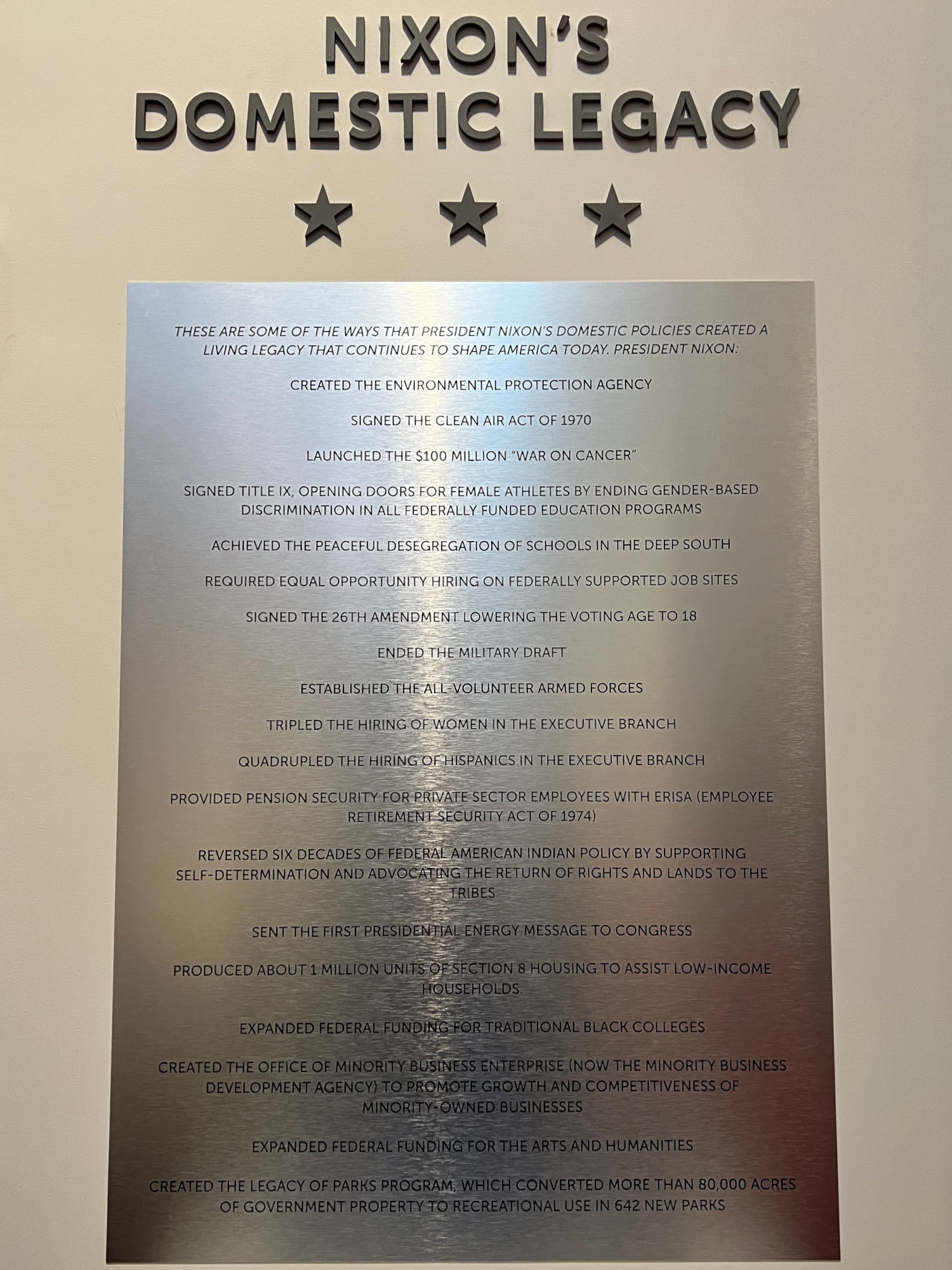
These are some of the ways that President Nixon's domestic policies created a living legacy that continues to shape America today.
President Nixon:
- Created the Environmental Protection Agency
- Signed the Clean Air Act of 1970
- Launched the $100 million "War on Cancer"
- Signed Title IX [eatlife.net/nixon-library/title-ix.php], opening doors for female athletes by ending gender-based discrimination in all federally funded education programs
- Achieved the peaceful desegregation of schools in the deep south
- Required equal opportunity hiring on federally supported job sites
- Signed the 26th Amendment lowering the voting age to 18
- Ended the military draft
- Established the all-volunteer armed forces
- Tripled the hiring of women in the Executive Branch
- Quadrupled the hiring of Hispanics in the Executive Branch
- Provided pension security for private sector employees with ERISA (Employee Retirement Security Act of 1974)
- Reversed six decades of Federal American Indian policy by supporting self-determination and advocating the return of rights and lands to the tribes
- Sent the first Presidential energy message to Congress
- Produced about 1 million units of Section 8 Housing to assist low-income households
- Expanded Federal funding for traditional black colleges
- Created the Office of Minority Business Enterprise (now the Minority Business Development Agency) to promote growth and competitiveness of minority owned businesses
- Expanded Federal Funding for the arts and humanities
- Created the Legacy of Parks program, which converted more that 80,000 acres of Government property to recreational use in 642 new parks




